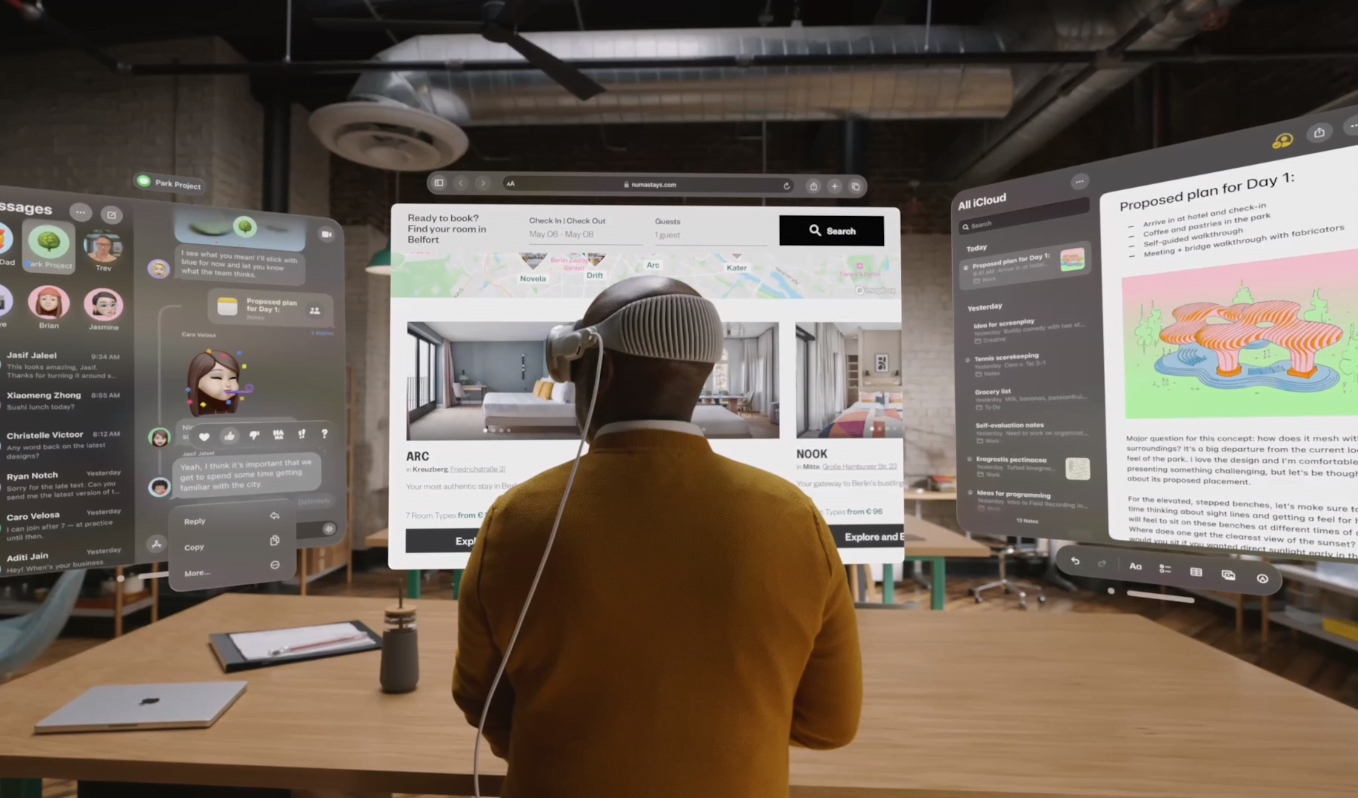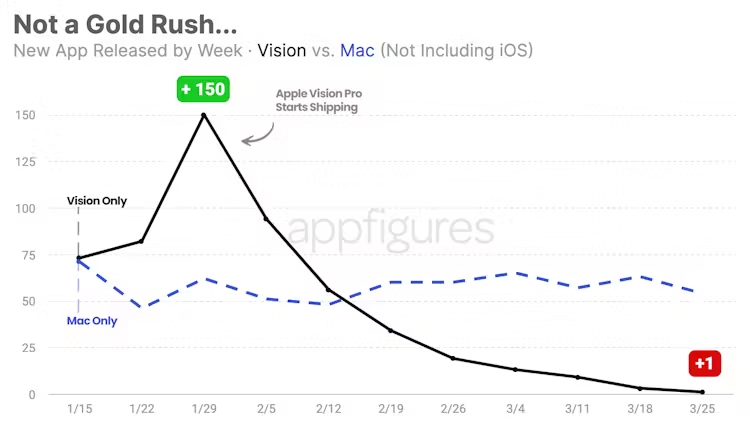
Was this newsletter forwarded to you? Sign up to get it in your inbox.
I cried the first time I used the Apple Vision Pro. Immersed in its virtual worlds, I saw a child blowing out the candles on a birthday cake. The picture was so crisp, the color so vivid, that my mind was fooled into believing I was actually there. My tears came because I realized that the promise of this device, if fully realized, would bring empathy at scale. The technological innovation of books was that they convincingly allowed us to live inside others’ minds. The Vision Pro allows us to see the world as other people do.
Now, two months after the device’s release, the potential I saw on that first day remains only partially fulfilled. That’s because the virtual reality device is sorely lacking in, well, any virtual reality. Apple has released a limited amount of content, and the third-party developer ecosystem is bare-bones. There just isn’t that much to experience—not yet, at least. Plus, there are flaws with the device itself. It’s far too expensive and too heavy, and the battery life isn’t good enough to support hours-on-end usage.
But virtual reality headsets have been ass for a decade—the Vision Pro just happens to have broken the threshold of assery. Other devices merely hinted at what was possible, but the Vision Pro is the first to deliver even a glimpse of genuine magic.
While we wait on Apple’s virtual reality universe to be fleshed out, there is an immediate way that it’s a game-changing technology. The Vision Pro is the single greatest entertainment device ever created. Watching a movie or a TV show on it is a vastly superior experience to any other option. It is a crystal-clear, IMAX-size screen you can use in your living room. It totally transforms the viewing experience of any content. Bad shows become good. Great shows become whiz! bang! pop! explosions of dopamine. Intentionally or not, Apple has actually improved Hollywood’s product for them. My chief complaint is that there isn’t an on-screen clock because I keep losing hours of my life using it without even realizing.
In a world awash with AI and new hardware, it is easy to dismiss the Vision Pro as an expendable gadget, a product in search of a purpose. But the device’s strengths are such a technological breakthrough that it augurs a new era of entertainment. If Apple can fulfill the promise of virtual reality, it can genuinely revolutionize computing—and fundamentally alter how we take in the world around us.
The screen replacement
Unless you have the good fortune of having a job that involves the outdoors, you probably stare at screens all day. There is little screen—your iPhone, ready with all of your emails and text messages the minute you wake up. When you’re ready for work, you graduate to medium screen—a laptop or monitor that handles your core workflows. Finally, the best part—big screen. Here you turn on the TV to watch a show or play a video game to wind down for the day.
According to one estimate, American consumers already spend an average of more than seven hours per day with a screen—and that feels low. You can quibble with the methodology and sources, but regardless, we’ve reached the point where every additional piece of hardware, software, or media we add to our lives needs to be a substitution for an existing service.
The question then becomes: In what way is the Vision Pro a superior screen? What does it replace?
Replace the big screen
What I most enjoy with the Vision Pro is entertainment. As someone who has gone on a date night at the movies every Friday for the past year, trust me when I say this: The Vision Pro is superior to the average movie experience. While the Vision Pro cannot compete with a higher-end Dolby Cinema or IMAX screen, that’s only due to the sound design in those rooms. It is a much better way to watch when compared to your local movie theater using a 15-year-old projector.
The image quality is roughly similar to that of an mid-upper-range OLED TV, which retails for around $1,750. The image feels crispy, with strong blacks and well-defined shapes. The difference is that the Vision Pro’s TV screen appears in your view in the size of an entire movie theater and can be used without leaving your home. It is also the first time I’ve ever enjoyed watching a 3D movie. (You need special glasses for those in theaters anyway.)
You can lay flat on your back on the couch, throw up a screen, and enjoy. No dealing with uncomfortable seats or other theater-goers who scroll Instagram throughout the movie. No pants required. The immersive nature will also keep you from scrolling at home like you might during a not-so-engaging episode of the latest Netflix show.
Additionally, the Vision Pro has Environments, like Yosemite or the moon, that surround the screen, removing all visual ephemera and making it so you can’t even see where you put your phone. When I’m watching a show on the Vision Pro, surrounded by outer space, I don’t even get the urge to check it.
Was this newsletter forwarded to you? Sign up to get it in your inbox.
I cried the first time I used the Apple Vision Pro. Immersed in its virtual worlds, I saw a child blowing out the candles on a birthday cake. The picture was so crisp, the color so vivid, that my mind was fooled into believing I was actually there. My tears came because I realized that the promise of this device, if fully realized, would bring empathy at scale. The technological innovation of books was that they convincingly allowed us to live inside others’ minds. The Vision Pro allows us to see the world as other people do.
Now, two months after the device’s release, the potential I saw on that first day remains only partially fulfilled. That’s because the virtual reality device is sorely lacking in, well, any virtual reality. Apple has released a limited amount of content, and the third-party developer ecosystem is bare-bones. There just isn’t that much to experience—not yet, at least. Plus, there are flaws with the device itself. It’s far too expensive and too heavy, and the battery life isn’t good enough to support hours-on-end usage.
But virtual reality headsets have been ass for a decade—the Vision Pro just happens to have broken the threshold of assery. Other devices merely hinted at what was possible, but the Vision Pro is the first to deliver even a glimpse of genuine magic.
While we wait on Apple’s virtual reality universe to be fleshed out, there is an immediate way that it’s a game-changing technology. The Vision Pro is the single greatest entertainment device ever created. Watching a movie or a TV show on it is a vastly superior experience to any other option. It is a crystal-clear, IMAX-size screen you can use in your living room. It totally transforms the viewing experience of any content. Bad shows become good. Great shows become whiz! bang! pop! explosions of dopamine. Intentionally or not, Apple has actually improved Hollywood’s product for them. My chief complaint is that there isn’t an on-screen clock because I keep losing hours of my life using it without even realizing.
In a world awash with AI and new hardware, it is easy to dismiss the Vision Pro as an expendable gadget, a product in search of a purpose. But the device’s strengths are such a technological breakthrough that it augurs a new era of entertainment. If Apple can fulfill the promise of virtual reality, it can genuinely revolutionize computing—and fundamentally alter how we take in the world around us.
The screen replacement
Unless you have the good fortune of having a job that involves the outdoors, you probably stare at screens all day. There is little screen—your iPhone, ready with all of your emails and text messages the minute you wake up. When you’re ready for work, you graduate to medium screen—a laptop or monitor that handles your core workflows. Finally, the best part—big screen. Here you turn on the TV to watch a show or play a video game to wind down for the day.
According to one estimate, American consumers already spend an average of more than seven hours per day with a screen—and that feels low. You can quibble with the methodology and sources, but regardless, we’ve reached the point where every additional piece of hardware, software, or media we add to our lives needs to be a substitution for an existing service.
The question then becomes: In what way is the Vision Pro a superior screen? What does it replace?
Replace the big screen
What I most enjoy with the Vision Pro is entertainment. As someone who has gone on a date night at the movies every Friday for the past year, trust me when I say this: The Vision Pro is superior to the average movie experience. While the Vision Pro cannot compete with a higher-end Dolby Cinema or IMAX screen, that’s only due to the sound design in those rooms. It is a much better way to watch when compared to your local movie theater using a 15-year-old projector.
The image quality is roughly similar to that of an mid-upper-range OLED TV, which retails for around $1,750. The image feels crispy, with strong blacks and well-defined shapes. The difference is that the Vision Pro’s TV screen appears in your view in the size of an entire movie theater and can be used without leaving your home. It is also the first time I’ve ever enjoyed watching a 3D movie. (You need special glasses for those in theaters anyway.)
You can lay flat on your back on the couch, throw up a screen, and enjoy. No dealing with uncomfortable seats or other theater-goers who scroll Instagram throughout the movie. No pants required. The immersive nature will also keep you from scrolling at home like you might during a not-so-engaging episode of the latest Netflix show.
Additionally, the Vision Pro has Environments, like Yosemite or the moon, that surround the screen, removing all visual ephemera and making it so you can’t even see where you put your phone. When I’m watching a show on the Vision Pro, surrounded by outer space, I don’t even get the urge to check it.
Enhance the medium screen
The ideal writing position for me involves burrowing into a heap of blankets and pillows, fully enveloped in a cocoon of coziness. The downside of this position is that I end up hurting my neck from craning at the laptop.
The Vision Pro’s Mac Extend feature solves that ergonomic problem. The Vision Pro creates a 4K mirror of your display. When paired with Environments, it becomes a focused work setup. I’ll fly through emails or writing sessions, knocking out items on my to-do list. I can also take short calls with the device on, though I’ve always felt funny using my Spatial Persona avatar during a company meeting. Something about doing a virtual representation of myself feels disrespectful, though that may have more to do with my deeply Midwestern sensibilities than reality.
Source: Apple.Create a new screen
When it comes to providing a selection of usable virtual reality experiences, the Vision Pro is a massive disappointment. Apple has released a grand total of five minutes of immersive video footage. The company has not released any additional Environments, nor did it include a single film or TV show specifically designed for the Vision Pro in its Apple TV lineup this year.
It’s a tough sell for independent developers, too. The device costs more than $3,000, plus a $2,000 developer license, and Apple still takes its usual App Store fees. Naturally, the volume of new apps has cratered.
Source: Appfigures.My virtual reality headset doesn’t actually get used for virtual reality all that much. It is mostly just a better screen. This isn’t the fault of the technology, but the fault of the ecosystem—an ecosystem Apple controls. Vision Pro apps are not developed in a vacuum. The company needs to convince large developers to port over existing applications and content to the Vision Pro. But most companies are tired of paying Apple its 30 percent dues. There is a reason Netflix and Spotify don’t make a dedicated app: It is a tiny moral stand to showcase their displeasure.
Depending on your levels of disposable income, the device is a home theater replacement and a productivity booster. It is not a device for gaming or virtual reality experiences. The Vision Pro is a great supplement to your medium screen and replacement for your big screen. However, it feels like Apple built the technical foundations for a dream home and decided to only finish the in-law suite.
The medium is (as always) the message
While I do not belong to the “all screens are bad” camp, I do believe that the level of distraction we live with is unhealthy. Constantly flipping through apps, social media feeds, and YouTube videos makes for an entertaining life, but not necessarily a meaningful one. The Vision Pro hasn’t replaced my Friday night dates to the movie theater, but it has replaced the time I used to spend mindlessly watching YouTube videos.
While that distraction is dependent on apps, the form factor in which we interact with those apps matters. As Marshall McLuhan argued, “We become what we behold. We shape our tools, and thereafter our tools shape us.” The Vision Pro is exciting because it demands the user be more focused, more present, less distracted. We put the device on to fully work or fully enjoy. Then, through the effort of taking it off, we unplug from the digital world.
I knew the Vision Pro had finally figured out how to do VR right the first day. After spending an hour with it, I took it off and went to show my wife something on my phone. Frustrated that the screen was too small, I did the pinch-and-expand motion with my fingers that, if I had been wearing the Vision Pro, would've thrown the screen up on our living room wall. I immediately grew frustrated with the little screen. If an hour of usage alters my paradigm of technological interaction, it is fair to say the device is a winner.
If the device is to grow into something desirable and accessible for casual users—you know, not nerds like me—Apple will need to work its technical magic: Make the device much lighter and more comfortable, and drop the price by at least 30 to 40 percent. It also needs to significantly invest in its developer and media ecosystem. There will be fewer than 1 million devices produced this year, so Apple will need to incentivize developers to bother to build anything Vision Pro-specific.
Perhaps the most remarkable thing about the Vision Pro is that despite all these flaws, despite having little content or few tailored apps, I love it anyway. It has brought a genuine joy to my home media experience. I’m cheering for the company to rapidly improve it so, ironically, we can spend less time on our iPhones, less time on our monitors, and more time focused and present.
Evan Armstrong is the lead writer for Every, where he writes the Napkin Math column. You can follow him on X at @itsurboyevan and on LinkedIn, and Every on X at @every and on LinkedIn.
Ideas and Apps to
Thrive in the AI Age
The essential toolkit for those shaping the future
"This might be the best value you
can get from an AI subscription."
- Jay S.
Join 100,000+ leaders, builders, and innovators

Email address
Already have an account? Sign in
What is included in a subscription?
Daily insights from AI pioneers + early access to powerful AI tools
Ideas and Apps to
Thrive in the AI Age
The essential toolkit for those shaping the future
"This might be the best value you
can get from an AI subscription."
- Jay S.
Join 100,000+ leaders, builders, and innovators

Email address
Already have an account? Sign in
What is included in a subscription?
Daily insights from AI pioneers + early access to powerful AI tools










Comments
Don't have an account? Sign up!
It's an interesting article, but I wonder why the Apple Vision Pro is getting so much more love than the Oculus Quest.
The Quest is everything the Vision Pro is not: it has a vast library of video games and media apps, it's cheaper ("30%-40%"), and is wireless.
I've never used the Vision Pro, but from everything I've seen, it is nowhere near as useful or interesting as the Oculus.
@blueballedmedia the quality is vastly different. If you use both, you will see that VPro is orders of magnitude better in quality and sheer capability. What the consumer has to weigh though, and this is to your point but said differently, is whether nor not those qualities are worth it for the price. Most consumers would agree that high end OLED tvs are better but some, if not most of them would not fork out 2K+ to get one because that level of quality is not necessary for them given the price point.
I think it's the same with VPro vs Quest.